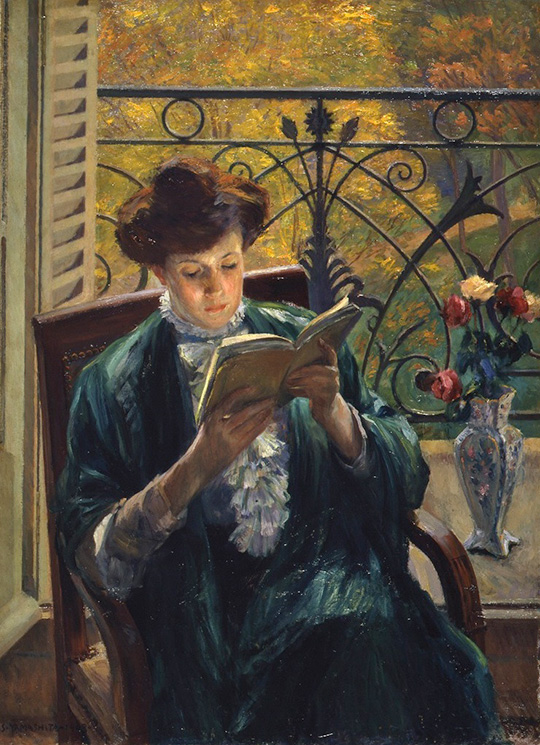Yamashita Shintaro (1881-1996), after skipping a year and graduating summa cum laude from the Tokyo School of Fine Arts, went to France to continue his studies in 1905. As he began his study abroad, he was profoundly impressed by Velasquez and, as a result, came to worry that he was so strongly emphasizing the shadows in his paintings that the colors were lost in the dark. As he pursued the study of color in an effort to escape the influence of Velasquez, he produced three paintings for which the model was a young woman reading a book.

Woman Reading, one of those paintings, was created in the fall of 1908, in an apartment Yamashita rented near the Sorbonne. The painting was selected for the Salon in May of the following year. In it the woman reading the book sits beside a window, enveloped in soft sunlight. Describing the bright, beautiful colors in this work, Yamashita said, “I expressed pleasant autumn colors through the woman in the painting . . . the primary tones are green and yellow (from the yellow leaves outside), which set off the rose tone of her face.” Five roses are arranged in the vase that sits on the balcony, contributing to the brilliance of the effect. The Yamashita Study Notes in our museum’s collection contain a sketch of part of a hand that is thought to be a preparatory drawing for this work. In it we see how the artist’s painstaking efforts extended to the positioning of each of fingers of the model reading the book.
Umehara Ryuzaburo, who was also studying in Paris at the same time, was Yamashita’s neighbor while he was painting Woman Reading and used the same model. Yamashita made his first visit to Renoir’s atelier, accompanied by Umehara, two months after Woman Reading was shown in the Salon. On meeting Renoir, Yamashita was deeply impressed, and visited again, bringing the painting on which he was working to ask for Renoir’s guidance. The advice he was given is embodied in the words with which this essay begins. Yamashita quickly recorded Renoir’s words in his notebook and treasured them throughout his life. Yamashita, who was taking his first steps to shed the influences of the past, found powerful support in this advice; its words were engraved on his heart.
That same year, Yamashita purchased Bather from Renoir. Believing that this small painting would be the finest Renoir in Japan, he immediately sent it home. It was then included in an exhibition; as the first oil painting by Renoir to be publicly displayed in Japan, it played a powerful role in Renoir’s reception here.
Curator:Natuko Tadokoro













Paintings are not things painted with the hand; they are things we see with our eyes. Thus, there is no need to keep works by earlier artists in mind. It suffices if we fully express the feeling we receive from nature. There is absolutely no need to fear making alternations as you paint. It is enough if we do what we can, if we paint until we have completely expressed what we feel.
—Advice given by Renoir to Yamashita
From Yamashita Shintaro, “Remarks on study in Europe,” in Water Lilies, vol. 9, no. 9, July, 1910.